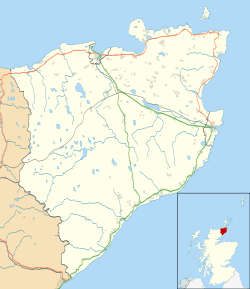Achvarasdal
Achvarasdal (from Scottish Gaelic Achadh Bhàrrasdail, meaning 'field of Barr's dale')[1] is a village in Caithness, Scotland, within the Highland council area.
Achvarasdal
| |
|---|---|
 | |
 Achvarasdal Location within the Caithness area | |
| OS grid reference | NC985647 |
| Council area | |
| Country | Scotland |
| Sovereign state | United Kingdom |
| Postcode district | KW14 7 |
| Police | Scotland |
| Fire | Scottish |
| Ambulance | Scottish |
| UK Parliament | |
| Scottish Parliament | |
Geography
Achvarasdal lies 1 mile (1.6 km) east of Reay, Thurso, in Caithness, Highland. Immediately to the south flows Achiegullan Burn and the Burn of Isauld. Achvarasdal Burn drains into Sandside Bay to the west.[2] Loch Achbuiligan lies to the north, and the hamlet of Isauld to the northwest.
Landmarks
The area includes a broch in which the lower parts of the wall are preserved, including a chamber and traces of a staircase.[3] The floor of the broch was covered with gravel in 2019 to stop weed growth, but there is still giant hogweed infesting the wallheads and surroundings.
There is a small outcrop of haematite iron at Achvarasdal.[4] Attempts at iron ore mining were made in the early 1870s, and an 1874 map reveals that a windmill was built, probably for pumping.[5] A cairn in the area indicates that it was a burial place of a Celtic maormer or a Norse warrior.[6]
Achvarasdal House and Wood
Achvarasdal House stands near the broch, in a patch of woodland that is accessible to the public.
The house was once owned by the Pilkington family.[4] The house and vicinity has been excavated and two prostrate stones and a brooch were discovered.[7][8] A. D. Pilkington of Achvarasdal House was the President of the local Gardener's Society in 1946.[9]
The house was used as a care home until 2019, run by Crossreach (formerly the Church of Scotland Board of Social Responsibility).[10]
The house and grounds are now privately owned as a family residence. [11]
The wood includes 19 native and several foreign tree species, and is home to a variety of lichens, mosses and invertebrates.[12] The wood is accessible by wheelchair.
References
- Gaelic and Norse in the Landscape: Placenames in Caithness and Sutherland Archived 2011-09-21 at the Wayback Machine. Scottish National Heritage.
- Phillips, Tim (2002). Landscapes of the living, landscapes of the dead: the location of chambered cairns of northern Scotland. Archaeopress. p. 169. ISBN 978-1-84171-291-8.
- "The Caithness Broch Project". The Caithness Broch Project. Retrieved 27 April 2018.
- Smith, John Smart (1988). The County of Caithness. Scottish Academic Press. pp. 97, 149.
- "ACHVARASDAL WOODLAND MANAGEMENT GROUP". Caithness.org. Retrieved 25 January 2014.
- Campbell, H. F. (29 November 2012). Caithness and Sutherland. Cambridge University Press. p. 56. ISBN 978-1-107-69280-0.
- List of ancient monuments in Scotland. HMSO, Scottish Development Dept. 1983. p. 16.
- Proceedings of the Society of Antiquaries of Scotland. Society. 1980. p. 133.
- Gardeners' Chronicle, Horticultural Trade Journal. Haymarket Publishing. 1946. p. 239.
- "Achvarasdal". Crossreach. Archived from the original on 6 October 2011. Retrieved 27 April 2018.
- "Former Caithness care home sold". John o' Groat Journal. Retrieved 26 March 2020.
- "9 Easy Walks In the Highlands of Scotland". Walking in Scotland. Retrieved 27 April 2018.